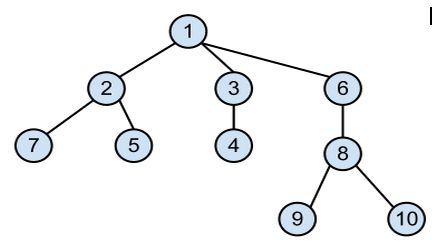interviewstreet - even tree
题目来源:https://www.interviewstreet.com/challenges/dashboard/#problem/4fffc24df25cd
解题报告:
这道题求一颗树,最多可以去掉几条边,使得被分割成的每颗单独的树的节点个数都是偶数。题目蛮有意思,难度适宜。
首先,将输入转换为树的格式,对每个节点,保留它的父亲节点和儿子节点的编号。
然后遍历树的每个节点,得到以该节点为根的树的节点个数(包括该节点)
对一个节点R,设它有儿子节点A,如果以A为根的树的节点个数有偶数个,则代表R与A这条边可以被去除,否则不可以。这样依次查找每个节点,看它与它儿子的边是否可以被去除,最后得到最多可以删去多少条边。
/* Enter your code here. Read input from STDIN. Print output to STDOUT */
#include <iostream>
#include <queue>
using namespace std;
int sum[101]; //以i为根的树的节点个数
int s[101][101]; //s[i][j]=1代表j为i的儿子
int p[101];
int adj[101][101];
int k;
int getSum(int index)
{
if (sum[index] != 0)
return sum[index];
int sm = 0;
for (int i = 0; i <= 100; i++)
{
if(s[index][i] == 1)
{
sm += getSum(i);
}
}
sm++;
sum[index] = sm;
return sm;
}
void findResult(int root)
{
for (int i = 0; i <= 100; i++)
{
if (s[root][i] == 1)
{
if(getSum(i) % 2 == 0)
{
k++;
}
findResult(i);
}
}
}
int main()
{
int N, M;
int root;
cin >> N >> M;
//initialization
k = 0;
for(int i = 0; i <= 100; i++)
{
sum[i] = 0;
p[i] = -1;
for (int j = 0; j <= 100; j++)
{
s[i][j] = 0;
adj[i][j] = 0;
}
}
for (int i = 0; i < M; i++)
{
int node1, node2;
cin >> node1 >> node2;
if (i == 0)
root = node1;
adj[node1][node2] = 1;
adj[node2][node1] = 1;
}
queue<int> q;
q.push(root);
while(!q.empty())
{
int node = q.front();
q.pop();
for (int i = 0; i <= 100; i++)
{
if (adj[node][i] == 1 && i!=p[node])
{
p[i] = node;
s[node][i] = 1;
q.push(i);
}
}
}
findResult(root);
cout << k << endl;
}
附录:
You are given a tree (a simple connected graph with no cycles).You have to remove as many edges from the tree as possible to obtain a forest with the condition that : Each connected component of the forest contains even number of vertices
Your task is to calculate the number of removed edges in such a forest.
Input:
The first line of input contains two integers N and M. N is the number of vertices and M is the number of edges. 2 <= N <= 100.
Next M lines contains two integers ui and vi which specifies an edge of the tree. (1-based index)
Output:
Print a single integer which is the answer
Sample Input
Note: The tree in the input will be such that it can always be decomposed into components containing even number of nodes.

